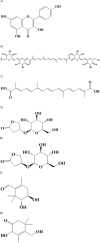Saffron (Crocus sativus) petal as a new pharmacological target: a review
- PMID: 30483381
- PMCID: PMC6251391
- DOI: 10.22038/IJBMS.2018.31243.7529
Saffron (Crocus sativus) petal as a new pharmacological target: a review
Abstract
Saffron petal is the main by-product of saffron processing which produced at high level but it is not applied and thrown out. Saffron petal is containing of several compounds such as mineral agents, anthocyanins, flavonoids, glycosides, alkaloids and kaempferol. As saffron petal is cheaper and produces in large amounts compared to saffron stigma, so, it can be considered as an appropriate source for different purposes. In this review different pharmacological properties of saffron petal such as anti-bacterial, anti-spasmodic, immunomodulatory, anti-tussive, anti-depressant, anti-nociceptive, hepato-protective, reno-protective, anti-hypertensive, anti-diabetic and anti-oxidant activity have been introduced. According to these properties, saffron petal can be used as an alternative or supplementary medicine in some diseases.
Keywords: Antidepressant; Crocus sativus; Hepatoprotective; Kaempferol; Metabolic syndrome; Saffron petal.
Figures
Similar articles
-
Possible therapeutic effects of Crocus sativus stigma and its petal flavonoid, kaempferol, on respiratory disorders.Pharm Biol. 2020 Dec;58(1):1140-1149. doi: 10.1080/13880209.2020.1844762. Pharm Biol. 2020. PMID: 33295229 Free PMC article.
-
Comprehensive Extraction and Chemical Characterization of Bioactive Compounds in Tepals of Crocus sativus L.Molecules. 2023 Aug 9;28(16):5976. doi: 10.3390/molecules28165976. Molecules. 2023. PMID: 37630227 Free PMC article. Review.
-
Flavonoid Composition and Antibacterial Properties of Crocus sativus L. Petal Extracts.Molecules. 2022 Dec 26;28(1):186. doi: 10.3390/molecules28010186. Molecules. 2022. PMID: 36615378 Free PMC article.
-
Petals of Crocus sativus L. as a potential source of the antioxidants crocin and kaempferol.Fitoterapia. 2015 Dec;107:128-134. doi: 10.1016/j.fitote.2015.05.014. Epub 2015 May 23. Fitoterapia. 2015. PMID: 26012879
-
[Research progress of chemical components and pharmacological effects of non-medicinal parts of Crocus sativus].Zhongguo Zhong Yao Za Zhi. 2018 Jul;43(14):2884-2891. doi: 10.19540/j.cnki.cjcmm.20180425.002. Zhongguo Zhong Yao Za Zhi. 2018. PMID: 30111046 Review. Chinese.
Cited by
-
Toxicity of Saffron Extracts on Cancer and Normal Cells: A Review Article.Asian Pac J Cancer Prev. 2020 Jul 1;21(7):1867-1875. doi: 10.31557/APJCP.2020.21.7.1867. Asian Pac J Cancer Prev. 2020. PMID: 32711409 Free PMC article.
-
Saffron (Crocus sativus L.) Flower Water Extract Disrupts the Cecal Microbiome, Brush Border Membrane Functionality, and Morphology In Vivo (Gallus gallus).Nutrients. 2022 Jan 5;14(1):220. doi: 10.3390/nu14010220. Nutrients. 2022. PMID: 35011095 Free PMC article.
-
Effect of Crocus sativus (Saffron) Intake on Top of Standard Treatment, on Disease Outcomes and Comorbidities in Patients with Rheumatic Diseases: Synthesis without Meta-Analysis (SWiM) and Level of Adherence to the CONSORT Statement for Randomized Controlled Trials Delivering Herbal Medicine Interventions.Nutrients. 2021 Nov 27;13(12):4274. doi: 10.3390/nu13124274. Nutrients. 2021. PMID: 34959826 Free PMC article.
-
Role of crocin in several cancer cell lines: An updated review.Iran J Basic Med Sci. 2020 Jan;23(1):3-12. doi: 10.22038/IJBMS.2019.37821.8995. Iran J Basic Med Sci. 2020. PMID: 32405344 Free PMC article. Review.
-
Effect of crocin, an active saffron constituent, on ethanol toxicity in the rat: histopathological and biochemical studies.Iran J Basic Med Sci. 2020 Jan;23(1):51-62. doi: 10.22038/IJBMS.2019.37133.8845. Iran J Basic Med Sci. 2020. PMID: 32405348 Free PMC article.
References
-
- Fernández J-A. Biology, biotechnology and biomedicine of saffron. Recent Res Dev Plant Sci. 2004;2:127–159.
-
- Rios J, Recio M, Giner R, Manez S. An update review of saffron and its active constituents. Phytother Res. 1996;10:189–193.
-
- Schmidt M, Betti G, Hensel A. Saffron in phytotherapy: pharmacology and clinical uses. Wien Med Wochenschr. 2007;157:315–319. - PubMed
-
- Hosseinzadeh H, Nassiri‐Asl M. Avicenna's (Ibn Sina) the canon of medicine and saffron (Crocus sativus): a review. Phytother Res. 2013;27:475–83. - PubMed
Publication types
LinkOut - more resources
Full Text Sources
Research Materials


